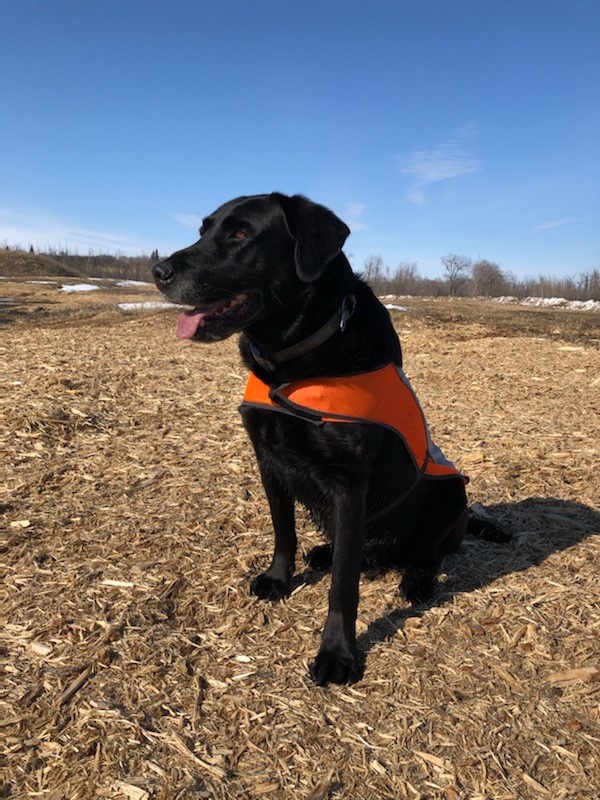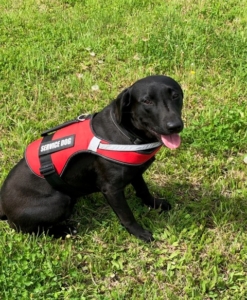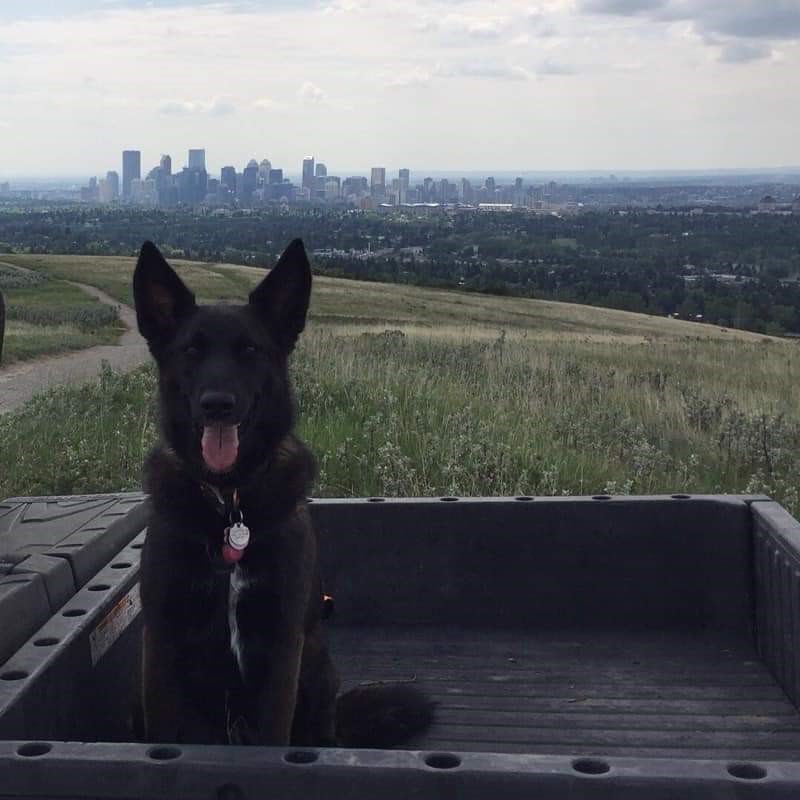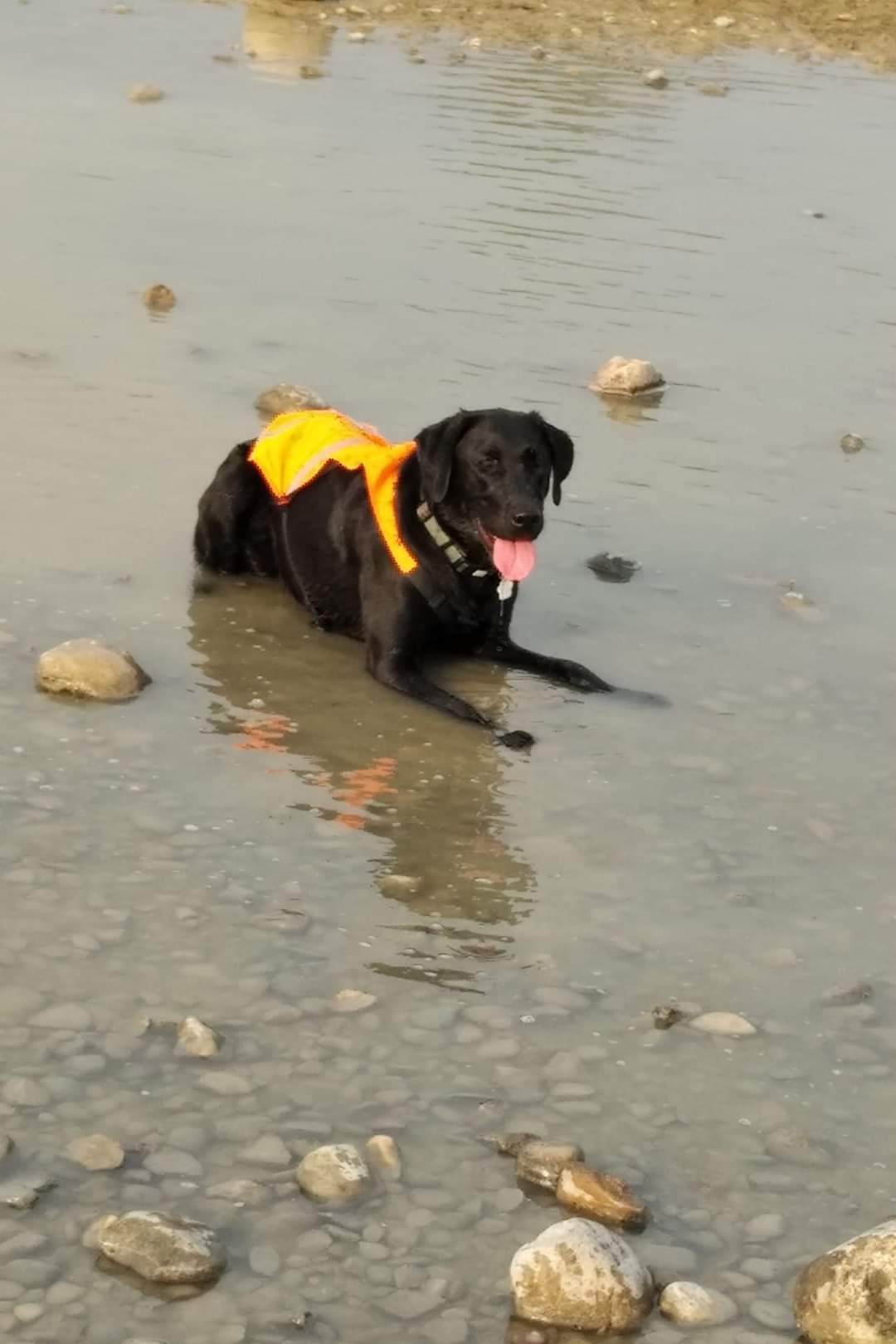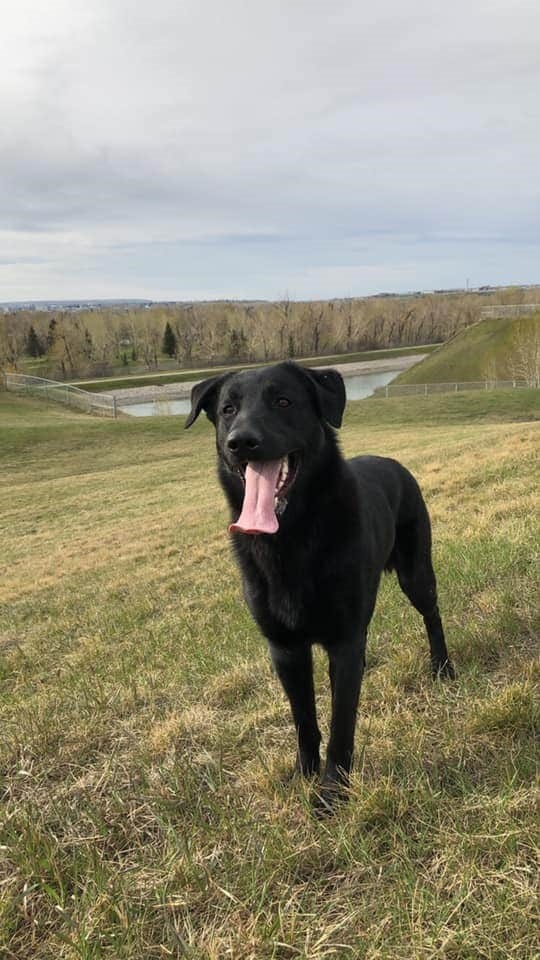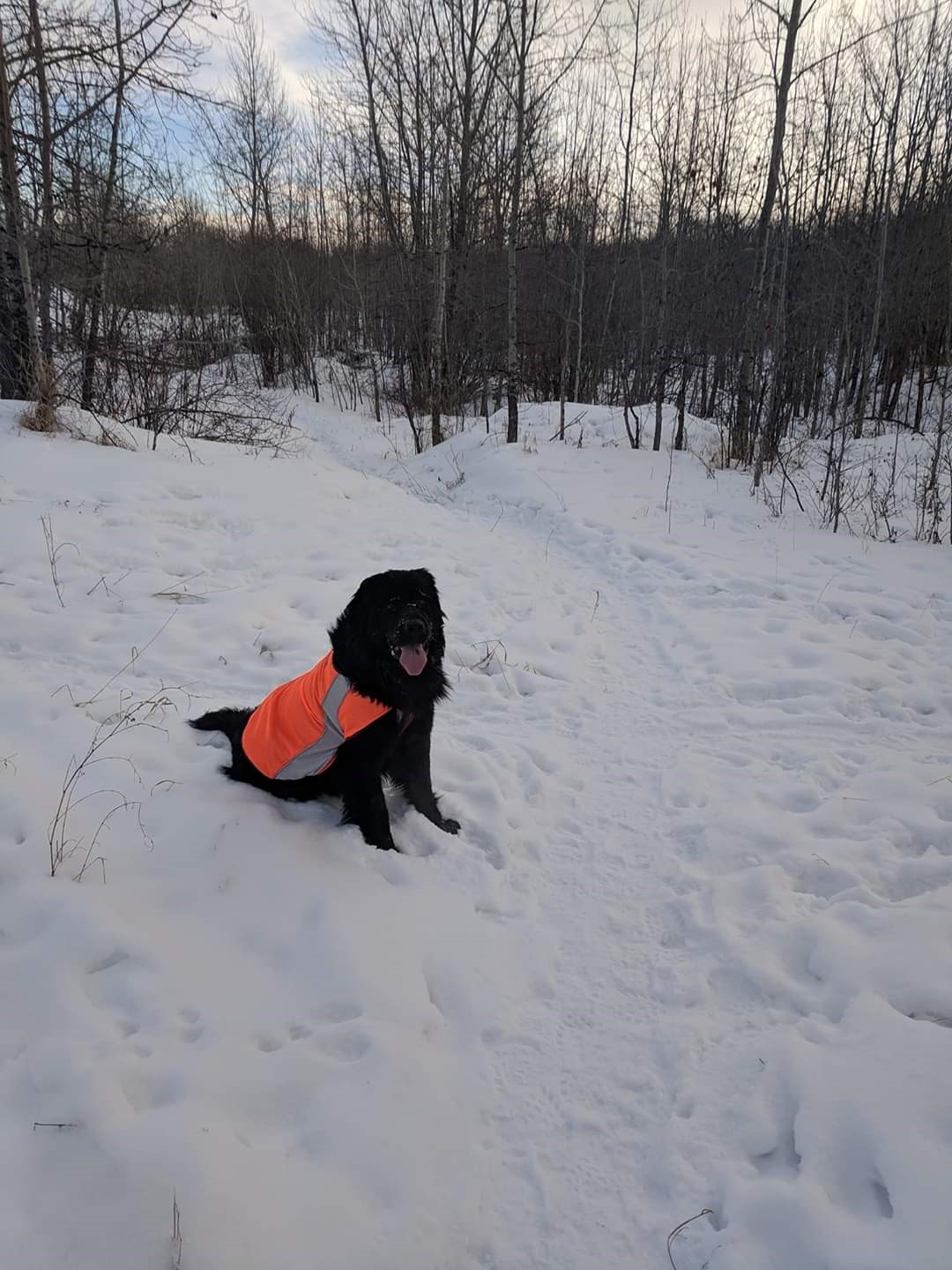Intro
Animal Damage Control (ADC) utilizes professional Service Dogs for a variety of wildlife management functions. Each dog is trained utilizing its individual strengths to assist our field teams in managing predator conflict security, migratory birds conflict mitigation, urban coyote conflict mitigation and any problem pest situation which benefits from service dog use. The dogs perform many tasks, using their keen sense of smell, natural hunting instinct and ability to take precise direction, ADC has developed a series of procedures which act to manage conflict humanely and without lethal intervention. Below is a list highlighting some of the many jobs ADC service dogs perform daily.
- Identify active dens, nests, and travel routes used by wildlife
- Engage aggressive predators (coyotes, wolves, bears, fox) and notify dog handler of impending threat
- Simulate residential pets in public parks and greenspaces, allowing dog handlers to engage aggressive coyotes with non-lethal deterrents
- Sweep active nesting areas and deter protected birds from nesting in conflict areas such as: pipeline ROW’s, construction sites, roadside ditches, sump ponds, tailings ponds, contaminated water
- Provide early detection of large predators such as Grizzly bear, Black bear, Cougar and Wolves
- Sweep the access, trials, and edges of remote sites, leases and workspaces for dens, aggressive predators
- Aid in the removal of geese nests in permitted areas under Federal CWS Migratory Bird Damage Permit
The Service Dog Advantage
ADC’s team of service dogs is comprised of many breeds of dog. Each with its own handler and set of skills. The relationship between handler and dog is key. Our dogs are raised from puppies, developing their skills at an early age. As they mature, they gain the skill and experience, making the dog/handler bond the foundation of the working team in the field. The main advantage of using working/hunting bred and trained dogs in the field is that due to their behavior, wildlife immediately regard them as being on a par with other wild canines and not family pets. Thus, the reaction is very different and predators’ sense immediately that they are being hunted and maneuvered by the dog and handler team.
ADC capitalizes on this instinctive reaction by wildlife which ranges from curiosity to wariness, threatened and sometimes territorial or aggressive behavior to manipulate or discourage habitation, and de-escalate conflict behavior and potential conflict situations. Often our dogs remain passive and on leash in order to initiate and attract aggressive behavior from predators so aversive conditioning techniques can be deployed by the handlers. Teams will often work in tandem either in alternating roles or to provide an overwhelming force when dealing with particularly aggressive animals.
Field Capability:
Coyotes
Coyotes are much more likely to become aggressive with a pet rather than the pet’s handler. So, by using a trained service dog to simulate a pet on a leash, we can draw aggressive coyotes into our handlers, and utilize not lethal deterrents such as paintball marker gun or air horn to re-educate coyotes to avoid pets and their handlers along public pathways or in any space used by local residents. As well, service dogs are able to detect coyote activity in around dens in public spaces. If there is a den in a location which will surely cause conflict, a service dog can sniff out and “mark” the den, often causing the coyotes to move den locations and therefore avoid future conflict. This reaction to the dog is much stronger than to a person, so the result is achieved passively.
Birds
Birds are another species which has a strong reaction to service dogs. ADC uses service dogs to passively push conflict birds from an area where they may endanger themselves or their nests. The reaction from the bird to the canine, which is a natural predator, is much stronger than to humans. Meaning the birds will avoid any area where they think the dogs may be working. This is especially apparent with migratory waterfowl, such as ducks, geese, and shorebirds. These birds will learn to avoid laying nests as well as feed anywhere a service dog is working. The dogs can cover 10x the area and distance of a person and can sweep areas consistently with little to no conflict with birds or nests. This allows industry to work through the summer nesting season and avoid conflict with protected birds.
Large Predators
Large predators often live within the workspaces of ADC’s clients. Bears, wolves, and cougar are the 3 species ADC consistently works with. The absolute safest way to avoid conflict with these animals, to know they are there! Most negative encounters with large predators occur because they are surprised or disturbed by unassuming human activity. ADC’s service dogs are used for early detection. Essentially, by utilizing the wind, and the dog’s keen sense of smell, ADC can detect any predator activity much sooner and further away than workers. The dogs will sweep an area, clear it of any danger and then stand guard for any predators who may be passing through. Any predator who is alerted will avoid the dog 99% of the time. In the off chance that the predator is aggressive, it will focus on the dog and allow workers to depart from danger.
Den locating and identification
Identifying active dens is another useful tool in avoiding conflict with predators. Often, workplaces must sweep for active dens in the fall prior to freeze up. Any area which is cleared of active vegetation must be swept throughout denning season. Any active bear den within a workspace must be marked and a buffer established. The service dogs perform two essential tasks in avoiding active dens. The first, if they are sweeping an area of concern consistently, the predator will avoid denning in this area in fear of compromising the den. The second, the dog will smell and alert of any active den within a workspace much more consistently than any tool workers have. Their nose misses nothing, meaning workers can sweep a large area very quickly and confirm any dens which may cause conflict.
Bill and Wallace (deceased)
Wallace was the foundation of the ADC service dog capability for more than a decade. Every management tool for wildlife involving service dogs has been tried, tested, and proven by Wallace. Wallace was a trained hunting dog with an exceptional nose and knack for flushing birds. Bill and Wallace were the first dog-handler crew deployed for Urban coyote management more than 10 years ago. Bill and Wallace developed the tactics ADC uses today, applying a dog’s ability to track and alert on aggressive predators, to search out conflict species and help deter dangerous wildlife. Wallace had tremendous athletic ability combined with astute hunting instinct. Wallace’s strengths and current role within the company are outlined below.
Strengths
- very disciplined for a high energy dog
- takes both verbal and hand calls very well
- a well learned sense of smell, able to indicate on multiple species and alert for each one
- 10 years of experience in working with all wildlife including birds, bears, cougar, and coyotes
- A large, physically superior male lab, able to deter predator aggression and protect workers at any cost
Birds
- Classically trained bird dog, able to search out nests, flush pest birds and alert on protected birds
- Can work in all environments, swims very well, not sensitive to the cold
- Can still cover a large area in a sweeping formation, allowing handler to clear large areas
- Uses his nose more than any other sense, does not miss a nearby bird
Coyotes
- Has worked with coyotes for 10 years
- Can draw coyotes to handler, sniff out fresh sign and alert on active dens
- Maintains composure if confronted with aggressive coyotes, will protect handler but stay in control
- Physically superior to most dogs, has a presence which draws a strong reaction from coyotes
Bears
- Wallace remains calm around large predators, but will indicate immediately on a bear in close proximity
- Able to work a large area and search out active den locations or recent sign
- Has worked mainly with black bears, but can provide early detection security on Grizzly bears as well
Physical Characteristics:
Breed: Pure bread Black Labrador Retriever
Height: 70.00 cm
Weight: 45kgs, 100bs
DOB: January 2007
Died: October 2021
Bill and Robbie
Robbie is Bill’s second dog. Robbie’s first year on the job was with Bill and veteran service dog, Wallace. Robbie has since grown into an energetic, highly athletic working dog. Bill and Robbie work together mainly in urban setting’s tracking and hazing aggressive coyotes. Robbie uses his keen nose and high energy to cover ground quickly and help locate wildlife. Robbie is very obedient and has become an important addition to the team. Bill and Robbie are together every day, forging a strong bind needed for an effective team. They both enjoy bird hunting and retrieving during the off days away from the field.
Strengths:
- Athletic and durable
- Very responsive to commands
- Energetic and able to work long hours
- Socialized and passive with family and members of the public
Birds:
- Used to push geese and other pest birds off their nests in locations ADC is permitted to remove nests
- Sweeps workspaces, ROW’s flushing birds form conflict areas to avoid nests or contact with chicks
- Locates active nests for handler so buffer can be established
- Intercepts aggressive pest birds and pushes from conflict area (aggressive geese in public parks)
Coyotes:
- Simulates a pet well and draws coyotes’ aggressive coyotes to close proximity with handler
- Not afraid to engage coyotes and potentially endure contact with aggressive coyotes
- Will stay under control while off-leash
- Used to verify active dens and indicate on fresh activity
- Utilized in urban environments where dogs must be always under control and obedient
Bears: (In training with large predators)
Physical Characteristics:
Breed: Black Labrador Retriever
Height: 69cm
Weight: 32kgs, 71lbs
DOB: July 2020
Peter and Sora
Peter and Sora have been the cornerstone of the ADC team for 6 years. Sora is a very disciplined dog, who acts immediately on command and is always extremely responsive to Peter. Peter and Sora have worked across Western Canada, on a wide range of worksites including pipelines, oil sands sites, large urban centres, remote worksites, and residential neighbourhoods. Sora’s strengths and roles within the company are outlined below:
Strengths:
- Excellent conditioning and athletic abilities
- Very responsive to commands, showing discipline in sensitive situations with bears, or vulnerable wildlife
- Protective of owner and property, will notify of potential danger immediately
- Passive and well mannered with children and members of the public
Birds:
- Used to push geese and other pest birds off their nests in locations ADC is permitted to remove nests
- Sweeps workspaces, ROW’s flushing birds form conflict areas to avoid nests or contact with chicks
- Locates active nests for handler so buffer can be established
- Intercepts aggressive pest birds and pushes from conflict area (aggressive geese in public parks)
Coyotes:
- Simulates a pet well and draws coyotes’ aggressive coyotes to close proximity with handler
- Not afraid to engage coyotes and potentially endure contact with aggressive coyotes
- Will stay under control while off-leash
- Used to verify active dens and indicate on fresh activity
- Utilized in urban environments where dogs must be always under control and obedient
Bears
- Has experience with both black bears and grizzly bears
- Will immediately indicate on the presence of a bear
- Used for early detection and general deterrent purposes in a variety of settings
- Sweeps for active dens
Cougar
- Used to push cougars in areas where we don’t want the cougar to retreat to a tree
- Will not bark or show aggression on cats if instructed to do so
- Utilized for cougar sweeps in urban areas
Physical Characteristics:
Breed: Belgian Malinois + Black Labrador Retriever
Height: 68.58 cm
Weight: 32kgs, 71lbs
DOB: July 23, 2016
Status: Environmental Service dog
Duncan and Keetah + Bear
Duncan and Keetah have been the backbone of our southern Alberta operations for 3 years. Bear, his second dog, is also used in certain circumstances. The main role of the service dogs in southern Alberta is ADC’s role in the city of Calgary’s Urban Coyote Management Program. Both Keetah and Bear were the first service dogs to begin working with coyotes in the Calgary. Keetah is extremely dedicated and can work long hours in any weather conditions. She is fearless, and willing to put her body on the line to engage very aggressive coyotes within the city. Both Keetah and Bear have extensive experience with coyotes and are the cornerstone of the program. Their Strengths and roles with ADC are detailed below:
Strengths:
Keetah
- Extremely energetic and willing to work long hours in any environment
- Excellent sense of smell
- Extremely agile, fast, and physically strong
- A veteran of coyote management, with keen understanding of protocol and procedure for deterring coyotes
- Very family oriented, passive with children and affectionate with the public
Birds
- Used to push pest birds (geese) in areas permitted for nest removal
- Deters birds from nesting in conflict areas
- Navigates water and wet conditions well, can smell birds in marginal conditions
- Sweeps large areas with ease, engaging birds but never making contact
Coyotes
- A journeyman coyote dog, well trained and keen on all coyote work
- Utilized in urban areas and parks
- Keen sense of smell for identifying active dens
- Will recall back to handler on command in tight areas
- Willing to enter dangerous situations with multiple aggressive coyotes
- Experienced in all landscapes including urban parks, green spaces, residential neighbourhoods, and construction sites
Bears
- Has experience with both back bears and grizzly bears
- Will sweep workspaces and alert on any fresh activity or bear sign
- Worked in Western Alberta on pipelines with high density of bears
- Will work the wind in a sweeping fashion to pick up smell of any potential threat
- Alerts on active dens in any environment
Bear
- Large, strong dog with durable physicality
- Keen nose
- Experienced with coyotes and able to be a team player when put in group setting
- Will engage aggressive predators and alert of danger immediately
Birds
- Flushes geese and other pest birds from conflict areas
- Keen sense of smell and diligent in sweeping for nesting habitat
- Some experience on ROW sweeps
Coyotes
- Lots of experience in urban areas with coyotes
- Works as a team with other service dogs
- Covers a large area and brings aggressive coyotes back to handler
- Alerts on active dens or fresh activity
Physical Characteristics:
Keetah
Breed: Black Labrador Retriever
Height: 72.25 cm
Weight: 29kgs, 65lbs
DOB: May 2017
Status: Environmental Service dog
Bear
Breed: Irish Wolf Hound, Black Shepard
Height:78 cm
Weight: 34kgs, 75lbs
DOB: May 2017
Malcolm and Richard
Richard has been a member of the ADC team since 2018. Richard’s strengths lie in his size and physical ability. Malcolm and Richard work particularly well with birds. Richard leaves no stone unturned, covering large areas with his nose meticulously. Richard is very kind in nature and a devoted family dog at home. He interacts with other pets and members of public well, never showing signs of aggression. Richard is very protective and will put himself in harms way to protect anyone. Richard’s strengths and roles within the company are outlined below:
Strengths:
- excellent sense of smell, will alert on a variety of findings including active den, bird nest, fresh scat, or urine
- protective of people and property
- enthusiastic to work, understands when its time to engage
- will always return when called
- gentle with small animals and pets, never sprayed by skunk, or had a porcupine quill
- has worked in a variety of worksites hazing birds and coyotes, including city parks, industrial worksites, pipeline ROW’s and remote locations
Birds
- is one of the most effective dogs we use in keeping birds from conflict locations
- misses nothing with his nose
- will not injure or engage chicks or fledgling’s
- can cover large distances for a big dog
Coyotes
- a journeyman with coyotes, working across central Alberta
- will alert on active dens
- will draw coyotes out to handler or push coyotes from conflict locations
- willing to defend anyone from serious aggression
- can interact with members of the public while working
Bears
- has worked in areas with both Grizzly and Black bear
- will alert of danger and immediately point to direction of threat
- can search out active dens and deter bears from denning in conflict locations
- fine to work alongside other crews while standing guard
Physical Characteristics:
Breed: Newfoundlander
Height: 75 cm
Weight: 50kgs, 112lbs
DOB: June 2017
Status: Environmental Service dog
Emily and Tony + Leroy
Emily has been a dog handler for nearly a decade, using both her dogs individually or as a team to haze birds, protect livestock, alert on nearby predators and hunt game birds during hunting season. Both Tony and Leroy bring a lot of experience to our team. Both labs have different personalities and bring their own set of skills to the work they do. They travel with Emily everywhere, gaining experience working in a variety of roles across western Canada. Emily and Tony/Leroy are a valuable asset to have working with us throughout the Alberta and British Columbia.
Strengths:
- excellent sense of smell, will alert on a variety of findings including active den, bird nest, fresh scat, or urine, and large predators
- enthusiastic to work
- will always return when called
- protective of livestock and other animals
- has worked in a variety of worksites hazing birds and coyotes, including city parks, industrial worksites, pipeline ROW’s and remote locations
- gentle with members of the public
Birds
- very experienced in keeping birds from conflict locations
- miss nothing with their nose and ability to differentiate priority species
- will not injure or engage chicks or fledgling’s
- both are high energy and can work all day searching for birds
Coyotes
- both are journeyman with coyotes, working across central and southern Alberta
- will alert on active dens
- will draw coyotes out to handler or push coyotes from conflict locations
- willing to defend anyone from serious aggression
- can interact with members of the public while working
Bears
- both work in areas with both Grizzly and Black bear
- will alert of danger and immediately point to direction of threat
- can search out active dens and deter bears from denning in conflict locations
- fine to work alongside other crews while standing guard
Physical Characteristics:
Tony
Breed: Black American Labrador
Height: 72cm
Weight: 40kgs, 87lbs
DOB: August 2nd, 2014
Status: Environmental Service dog
Leroy
Breed: Black American Labrador
Height: 78cm
Weight: 37kgs, 78lbs
DOB: September 3rd, 2019
Status: Environmental Service dog
Paul and Taz
Paul and Taz are the newest members of our canine team. Working mostly in southern Alberta, Taz has been with Paul most of 2022 working in urban parks, natural areas, and greenspaces with coyotes. Taz is a large dog, with a lot of power and presence. Paul can maneuver on aggressive coyotes and know Taz will be in control and able to defend Paul if necessary. They have been working in high-profile areas near many other dogs and residents, Taz is very friendly and able to decipher between pets and targeted wildlife. Hazing coyotes, tracking coyotes, and helping to push coyotes from conflict spaces are Taz’s speciality. Paul and Taz also work with birds, helping to locate nests and haze birds from nesting in conflict areas. Taz continues to work alongside Paul helping to implement our Urban Coyote Management programs.
Strengths:
- excellent sense of smell, will alert on a variety of findings including active den, bird nest, fresh scat, or urine, and large predators
- loyal and eager to work
- will do anything to protect Paul or another person
- has worked in a variety of worksites hazing birds and coyotes, including city parks, greenspaces, residential neighbourhoods, and natural areas
- large and powerful, able to deter other aggressive predators
Birds
- some experience in keeping birds from conflict locations
- uses his nose and high energy to cover ground
- will not injure or engage chicks or fledgling’s
Coyotes
- becoming a journeyman with coyotes very quickly, working across central and southern Alberta
- will alert on active dens
- will draw coyotes out to handler or push coyotes from conflict locations
- willing to defend anyone from serious aggression
- can interact with members of the public while working
Bears
- grew up around large predators
- will bark and alert on any large predator including bears
- gaining experience in working with bears in various settings
- can locate fresh bear activity including potential dens
Physical Characteristics:
Taz
Breed: Staffire Terrier
Height: 73cm
Weight: 38kgs, 85lbs
DOB: June 2010
Status: Environmental Service dog

